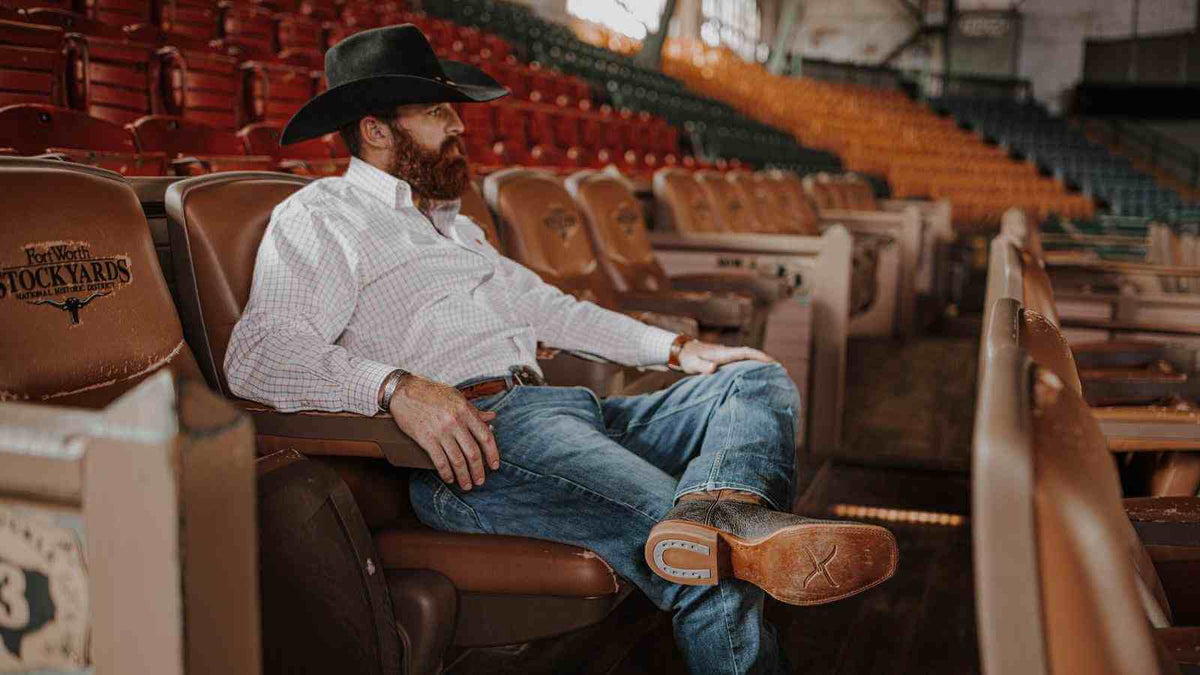Feather X™
Light weight, casual, comfort
BrowseTime to read 4 min
Walking a mile in someone else's shoes might be a wise saying, but if those shoes are ill-fitting Western boots, that mile will feel like a marathon. The importance of a proper fit can't be overstated. Not only do boots that fit well amplify your confidence, they also save you from unnecessary discomfort or pain. But how should Western boots fit? Keep these important considerations in mind as you begin your search for the perfect fit.
Before you start shopping for Western boots, you must nail down an important detail: your foot size. Similar to the difference in how a tailored suit feels versus a borrowed jacket, a boot that matches your foot size perfectly can ensure a lasting comfort that feels personalized.
At Home: Measuring your foot at home is simpler than it sounds. All you need is a ruler, a pen, and a piece of paper. Start by placing your foot firmly on the paper. Then, mark the very end of your longest toe and the backmost part of your heel. Now, measure the distance between these two points either in inches or centimeters. An essential tip to remember: our feet aren't always identical twins. Always measure both to ensure you're accommodating for any slight size variations.
In-store: If DIY isn’t quite your style or you want a second opinion, then visiting a store may be your best bet. Professional shoe stores usually come equipped with a Brannock device—a specialized tool designed for foot measurements. It might look familiar, even if the name doesn’t ring a bell. With its help, you take precise measurements, consult the brand sizing chart, and ensure your new boots will fit like a glove, from heel to toe.
When it comes to Western boots, the toe box plays a significant role in overall comfort. It's essential that your toes have ample room to move without feeling squeezed or loose and insecure. A proper toe box should provide a snug environment, allowing your toes to lay naturally. As you browse different Western boots, you'll notice a variety of toe shapes available—from pointed designs to more spacious rounded or square options. Your choice should reflect your style and align with your foot's natural shape so that each step feels as good as the boot looks.
The heel of a boot is an equally relevant factor in comfort. If you're new to the Western boot world, you might be surprised to find that a little heel movement isn't a bad thing. In fact, when trying on a new pair, a slight slide of the heel is a positive sign. It's a part of the boot's design to accommodate foot dynamics as you walk.
Initially, there might be a temptation to equate this small movement to a misfit. But, as many boot wearers will tell you, this is a hallmark of Western design. As you wear and break in your boots, they'll mold to the shape of your feet, and this movement will decrease.
Now, onto the height of the heel. Heel height is usually crafted to align with the boot’s intended purpose- be it riding, working, or casual wear- however, it can also contribute to overall comfort. So, when you're out shopping, pay special attention to how different heel heights affect the angle, support, and placement of your feet within the boots.
When you think about what makes a boot comfortable, arch support might not be the first thing that comes to mind. But it plays a big role in how your feet feel at the end of the day. Just like a good mattress supports your back, the right arch support in a boot provides lift and cushion for your feet.
Your foot's arch is designed for balance and support, and when inadequately fitted, the discomfort may be hard to ignore. Your ideal boot acts like a custom cushion for your arch, ensuring every step is perfectly in sync with your foot’s natural shape.
Focusing on this subtle yet vital aspect is imperative when trying on Western boots. The arch area of the boot should align well with your foot, giving a snug yet flexible feel. If you notice any unusual pressure or, on the opposite end, a feeling of emptiness under your arch, it might be worth exploring other options. The right support will keep foot fatigue at bay, making long days spent in your boots feel like a breeze.
There's an old saying that all good things take time, and this rings especially true for new Western boots. Fresh out of the box, they might feel a little stiff, but as you wear them, they become more fit for you and give you all-day comfort.
Around the House: Start by wearing your new boots indoors. As tempting as it might be to immediately show off your new boots, first wear them while you're relaxing at home. This lets the boots gently adapt to your foot's shape in a controlled environment.
Out and About: As your boots start feeling like part of you, take them on brief outdoor trips. Perhaps a quick brunch with friends or a short errand. These mini-adventures will allow the boots to flex and mold to your feet while adapting to different terrains. The initial stiffness will melt away with time, replaced by a comforting, custom fit.
The boots you choose, much like paths in life, should reflect who you are and ensure each step is taken with comfort and confidence. That’s why understanding how Western boots should fit is important. When you know how to size and fit your Western boots to your feet, you’ll feel ready to take on any day.
Learn more about the Twisted X Western Boot Collection by visiting our website or exploring our collection at a local retailer near you.



